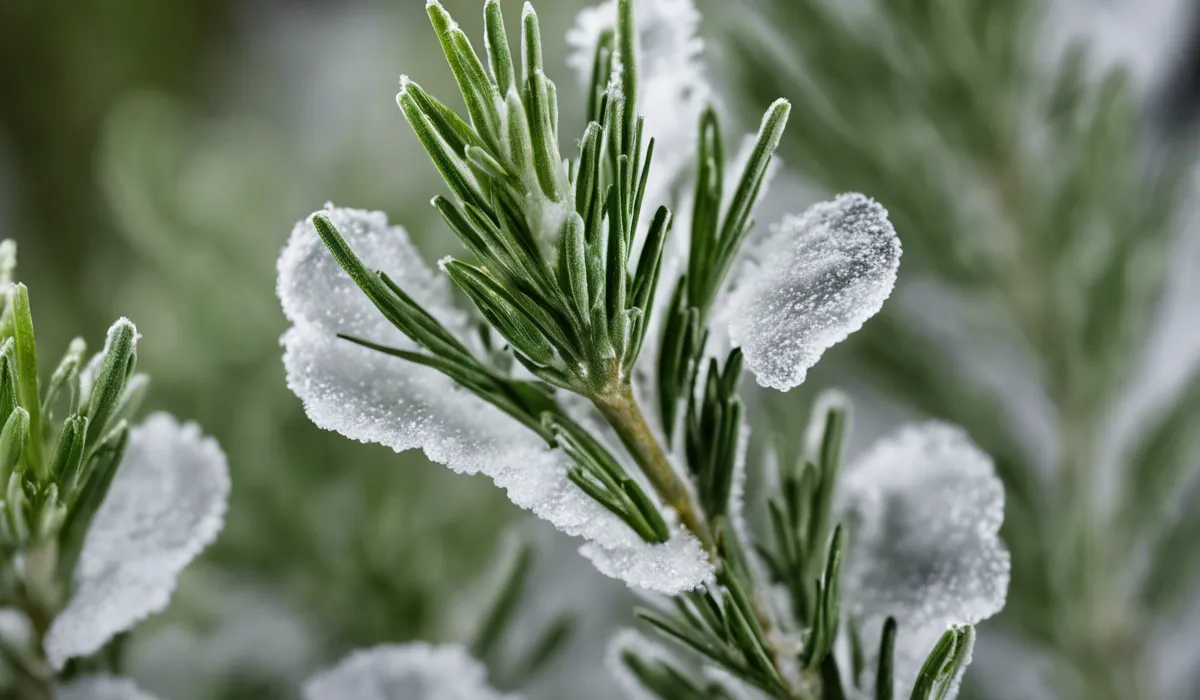Eating rosemary with powdery mildew is not recommended. Powdery mildew is a fungal disease that can be harmful if ingested. It’s best to remove affected parts or avoid consumption entirely to ensure safety.
Understanding Powdery Mildew on Rosemary

Definition of Powdery Mildew
Powdery mildew is a common fungal disease that affects a wide variety of plants. It appears as a white or gray powdery coating on the leaves and stems.
This fungus thrives in warm, dry climates with cool nights, which can make rosemary, a plant that enjoys similar conditions, susceptible.
Impact on Rosemary Plants
When rosemary is infected with powdery mildew, its growth can be stunted. The plant may also become less flavorful and aromatic, which is important to consider since rosemary is widely used for culinary purposes.
In severe cases, the mildew can weaken the plant, making it more susceptible to other diseases and pests.
Identifying Powdery Mildew on Rosemary
Visual Signs
Look for a white or gray powdery substance on leaves and stems. It can start as small spots that gradually merge and cover large areas of the plant. Infected leaves may turn yellow and dry out, potentially leading to defoliation.
Possible Causes and Conditions
Powdery mildew on rosemary often occurs when there is poor air circulation, high humidity, and moderate temperatures.
Overhead watering can also contribute to its spread by splashing spores onto healthy foliage.
Common Misconceptions About Powdery Mildew on Herbs
Many believe that powdery mildew is just a cosmetic issue and that the herbs are still safe to consume.
While the mildew itself is not deadly, it can lead to health concerns, which brings us to understand the risks associated with consuming infected rosemary.
Health Implications of Consuming Mildew-Infected Rosemary

Potential Health Risks
Allergies and Respiratory Issues
Consuming rosemary affected by powdery mildew can exacerbate allergies and cause respiratory issues in sensitive individuals.
It is particularly risky for people with compromised immune systems or existing respiratory conditions.
Mycotoxins and Health Effects
Mildew and molds on plants can produce mycotoxins, which are toxic compounds that can lead to health issues if ingested over time.
These toxins have been linked to a range of adverse health effects, including immune system suppression and organ damage.
Expert Opinions on Consuming Mildewed Herbs
Experts generally advise against consuming herbs with visible signs of powdery mildew. The risks associated with the potential ingestion of mycotoxins outweigh the benefits of the herb’s nutrients.
Guidelines for Herb Usage
If you encounter rosemary with powdery mildew, it’s best to avoid using the infected parts.
When in doubt, err on the side of caution and discard the affected sections of the herb to ensure safety.
Safe Practices for Handling and Using Rosemary with Powdery Mildew

Preventative Measures
Proper Plant Care
Maintaining good air circulation around your rosemary plants and providing adequate spacing can help prevent the onset of powdery mildew. It’s also important to avoid overhead watering to reduce spore spread.
Environmental Controls
Monitoring humidity levels and ensuring the growing area has good ventilation can significantly reduce the risk of powdery mildew developing on your rosemary plants.
Handling Infected Rosemary
Cleaning and Discarding Infected Parts
When you spot powdery mildew on your rosemary, remove and discard the affected parts immediately.
Be sure to clean your gardening tools after handling infected plants to prevent spreading the mildew spores.
Techniques for Mildew Removal
While washing may remove some of the mildew, it is not a guaranteed method for eliminating all spores or toxins. It is often safer to simply discard the contaminated parts rather than attempting to clean them.
Alternative Uses for Rosemary
Aromatic Purposes
Rosemary that is not fit for consumption can often still be used for its aromatic properties. You can dry unaffected parts of the plant and use them for fragrant sachets or potpourri.
Crafting and Decoration
The sturdy stems of rosemary can be used in crafts or as decorative elements in flower arrangements.
Just ensure that any mildewed parts do not come into contact with edible items or sensitive surfaces.
When to Discard Rosemary Due to Powdery Mildew?
If powdery mildew has spread extensively throughout the rosemary plant, it may be time to remove and discard the plant entirely.
Starting fresh with a new plant and using preventative measures can help ensure a healthy, mildew-free future for your herbs.
FAQs About Eating Rosemary with Powdery Mildew
Can you safely eat rosemary that has powdery mildew?
No, it is not safe to eat rosemary with powdery mildew due to the potential harmful effects of ingesting the fungus.
What should you do if your rosemary plant has powdery mildew?
If your rosemary plant has powdery mildew, you should remove the affected parts and avoid consumption of any diseased portions.
Is powdery mildew on rosemary harmful to humans when ingested?
Yes, powdery mildew is a fungal disease that can be harmful if ingested by humans.
Can powdery mildew be washed off rosemary for safe consumption?
While washing may remove some mildew, it is not guaranteed to make the rosemary safe for consumption; affected parts should be discarded.
Are there any risks in using rosemary with powdery mildew for cooking?
Yes, using rosemary with powdery mildew for cooking poses a risk as the fungus can be harmful when ingested, even after cooking.
Final Thoughts
Eating rosemary affected by powdery mildew is unsafe. This fungal disease poses potential health risks when consumed.
It is advisable to discard the contaminated parts of the plant or refrain from using the herb altogether to maintain food safety and avoid the ingestion of harmful pathogens.
